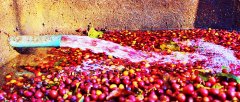Chocolate basic tone and special flavor-- chocolate pounding

For professional baristas, please follow the coffee workshop (Wechat official account cafe_style)
Special tone of chocolate flavor, cup test smell with grease aroma to bring out a slightly sweet vanilla flavor, immediately after the entrance feel rich fat full, chocolate fragrance, rich but delicate taste, nut aroma pull chocolate texture, sucrose sweetness refreshing, quite balanced bitter, sour, sweet, rich finish. 、
Chocolate pounding-conveying the warmth of emotion with a warm heartbeat. Whether it is the company of friends, the support of family or the sweetness of lovers, welcome the new year with a thumping heart of gratitude.
South America in South America, Africa in Africa, Asia in Asia
Arabica Arabica
[baking degree] moderate baking Medium
Aroma: grease aroma, plus chocolate
Sweetness: freshness and sweetness of sucrose
Acidity: low-key slightly acidity
Palate: full and balanced greasy feeling
Christmas Plan-- Chocolate pounding
The warm heartbeat is the unique feeling that the coffee hunter wants to bring to everyone this time. Coffee hunters mix a selection of Arabica beans from South America, Africa and Asia to mix thick and balanced chocolates. With a cup of coffee with chocolate flavor, it conveys emotion and warmth in this cold December season. Whether it's the support of family, the company of friends, or the sweetness of lovers, spend this beautiful and joyful Christmas with a thumping heart of gratitude.
Bon2
About Arabica?
Arabica coffee is one of the most important coffee trees in the world, and its origin is Ethiopia. At first, Arabica coffee was used as medicine. In the 13th century, people began to roast and drink coffee beans. In the 16th century, Arabica coffee was introduced into Europe through Arabia and became a favorite drink. Arabica's excellent flavor and aroma make it the only native coffee that can be drunk directly.
At present, the main producing areas are in South America, Central America, Africa and Asia, and a small amount of this bean seed is also grown in Taiwan. Most Arabica is grown commercially, and only Ethiopia and neighboring South Sudan have wild Arabica in a few areas.
Although there are many varieties of coffee now, in the final analysis, there are only two kinds of artificial cultivation. One is Arabica, and the other is Robusta, both of which are introduced by wild species.
Coffee made from Arabica beans will be of higher quality, lower caffeine content and unique flavor than other commercially grown coffee varieties. Generally speaking, Arabica beans have a strong aroma, no bitterness and high acidity.
Coffee trees planted in Arabica are usually planted at an altitude of 900murmur2000 meters above sea level, with a temperature of about 15mur24 ℃, requiring higher humidity and annual rainfall of more than 1500 milliliters, and higher cultivation techniques and conditions.
Due to climate warming, research from the Royal Botanical Gardens in London points out that the world's largest variety of Arabica coffee will be extinct in the wild by 2080. Scientists believe that the genetic diversity of coffee in coffee plantations is less than 5% of that of wild coffee, and the narrow gene pool makes artificially grown coffee very vulnerable, so if wild species become extinct, the weakness of artificial cultivation will not be able to resist the attack of natural predators. as a result, the quality of coffee will decline, causing prices to soar.
Important Notice :
前街咖啡 FrontStreet Coffee has moved to new addredd:
FrontStreet Coffee Address: 315,Donghua East Road,GuangZhou
Tel:020 38364473
- Prev

The twelve wonderful uses of coffee grounds-- can you actually wash your face and hair?
Professional barista communication Please follow the coffee workshop (Wechat official account cafe_style) after drinking coffee, what do you do with the coffee grounds left behind? Most people will choose to throw it away, but did you know that coffee grounds are still of great use? Coffee itself absorbs oil and smells, which makes coffee grounds a good cleaning deodorant and a good helper at home. What is more fascinating to the girls is
- Next

Spring Rain with a faint fragrance of Vanilla-- the Romance of the Vietnamese
Professional baristas please pay attention to the coffee workshop (Wechat official account cafe_style) cup test fresh vanilla aroma with a hint of spice, chocolate hazelnut overflowing after the entrance, enhance the overall flavor level, smooth and smooth taste, gently with sweet smell of sugar, the overall taste is clean, refreshing, soft and smooth. [Origin] Asia, Africa, South America [flavor] spices, Qiao
Related
- The milk tea cup becomes smaller?! Overlord Tea Girl launches a new "Return to Yunnan" series
- Accused of selling counterfeit and high-priced coffee beans! Well-known boutique coffee brand "Oukelao" bowed and apologized!
- How to make espresso dumplings? Can I eat coffee and glutinous rice balls together?
- Save the unformed and stagnant powder cakes in one second! What is the problem with stagnant water in the powder bowl of the espresso machine?
- What does hand-brewed coffee stop mean? Why is it not recommended to make coffee by hand?
- Is it normal to smell like coffee? Why does coffee smell like alcohol? What's wrong with the strong smell of cold extract ice dripping ice brewed coffee?
- How to solve the problem that hand-brewed coffee extraction takes too long? Why is the water flowing so slowly when making coffee?
- The main points of making Australian white coffee, the proportion details, how does Australian white properly foam and blend the flowers?
- Can ice water make cold extract coffee? What is the difference between room temperature water and ice water for making cold coffee?
- What milk is best for making latte and white Dirty coffee? What is the difference between different brands of fresh milk and pure milk for making coffee?

